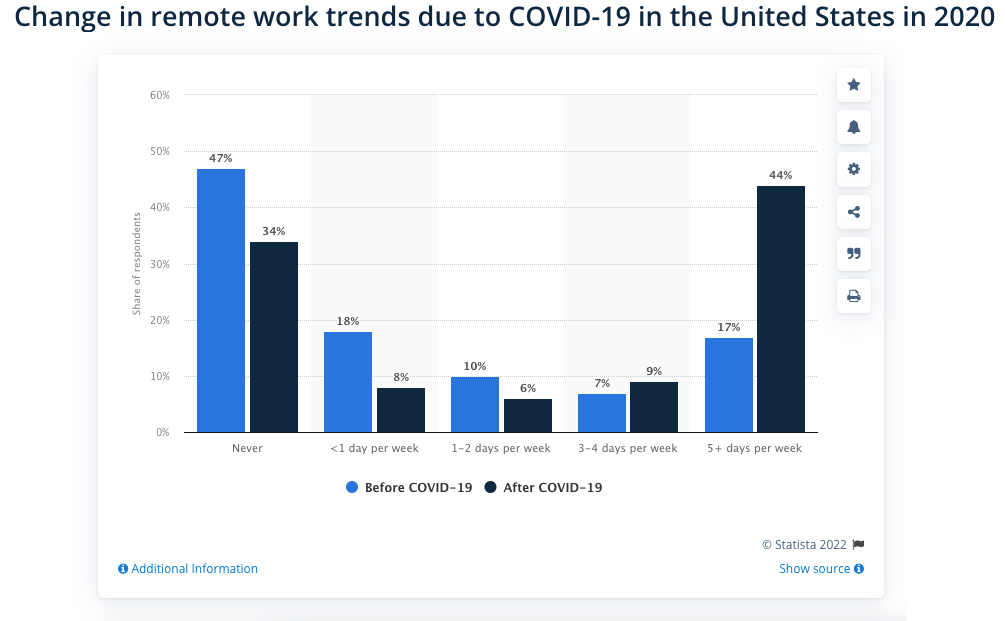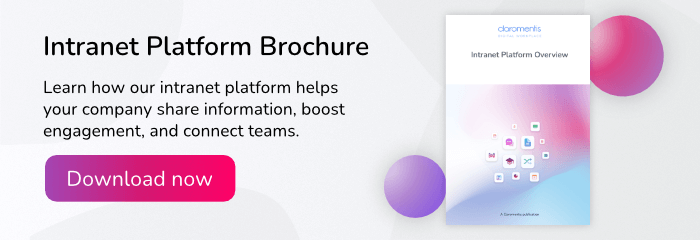The number of people working remotely continues to grow.
A recent study by Statista found that 44% of US employees worked remotely after COVID-19, up from 17% before COVID-19. The spread of the pandemic hastened the adoption of remote working, as quarantines and lockdowns made traveling to and working in a workplace near impossible for millions throughout the world.
Employees could still manage projects from home, and stay in touch with co-workers and clients, thanks to advanced technology and collaboration solutions that allowed them to perform their tasks away from the office.

(Image source: statista.com)
While there are many benefits to remote working, it can also present challenges concerning effective collaboration.
This article will discuss how you can use an intranet collaboration solution to overcome these challenges and enable your remote workers to collaborate effectively.
Challenges of remote working
There are disadvantages of remote work that companies must address to succeed in the new hybrid working environment. Some of these challenges include:
- Less collaboration: Employees who work from home are more likely to communicate with their colleagues via email, instant messaging apps such as Skype or WhatsApp for Business, and other collaboration solutions. While a collaboration tool has advantages, remote working can lead to less collaboration because it is harder for employees to meet face-to-face. This can make it difficult for them to build relationships and promote a sense of belonging within the organisation.
- Less engagement: Engagement is the commitment and sense of belonging that employees feel towards their organisations. It has been shown to positively impact an employee’s productivity, motivation and job satisfaction. However, when employees work remotely, they can often feel disengaged from the organisation if they do not have strong relationships with their colleagues or do not feel that their work is essential and contributes to the company’s overall success.
- Less accountability: In an office, managers can easily monitor their employees’ work and ensure they meet deadlines. However, this is not possible when employees work remotely because of the lack of physical oversight. As a result, remote workers are often less accountable for their actions.
- Isolation and loneliness: Remote workers may feel isolated and lonely because they do not have the same face-to-face interaction with their colleagues as previously. This can lead to feelings of loneliness that negatively impact an employee’s mental health and wellbeing over time.
- Lack of recognition: Employees who work from home are less likely to be recognised for their achievements by their managers and colleagues. This is because the remote worker’s accomplishments are not as visible to those not working from home.
- Decreased work-life balance: When employees work remotely, they often work longer hours than they would if they were in the office. This is due to the lack of physical separation between work and home life. This can lead to a decreased work-life balance, as employees are unable to relax and disengage from their work after hours.
How an intranet collaboration solution can address these challenges
An intranet collaboration solution is a secure online platform that enables employees to collaborate effectively regardless of their location. It allows companies to build on the advantages of remote working and overcome the challenges of remote collaboration.
Collaboration
An intranet collaboration solution facilitates collaboration by enabling employees to communicate with each other via instant messaging, email, voice or video calls and online forums. It also allows them to share files, documents and links from one place in real-time so that everyone can work on projects together.
Engagement
Intranet team collaboration tools can promote employee engagement by giving them access to information about the organisation, such as its mission and values. It also allows team members to contribute their ideas in an online forum where they are likely to be heard by managers who monitor these forums regularly. This gives employees a sense of belonging because they feel that they are contributing to the success of their organisation.
Accountability
An intranet collaboration tool can help managers hold employees accountable for project management by providing a platform to track an employee’s project progress and deadlines. Managers can also set up alerts to notify them when an employee has not met a deadline or uploaded a file that they were supposed to. This ensures employees are held accountable for their actions and do not take advantage of the remote working environment through procrastination.
Interaction
Intranet software can help reduce feelings of isolation in remote workers by providing a place to interact with team members via internal messaging, communication spaces and corporate social media. An enterprise social network is particularly valuable in this regard, allowing employees to post questions, thoughts, suggestions, photos, links, and other content, discuss ideas, and “like” and share each other’s posts. In this way, corporate social networks connect dispersed teams, allowing workers to feel like they are in the same room working on projects together, even when they’re miles apart.
Read more: The Top 5 Benefits of a Corporate Social Network
Recognition
The company intranet also facilitates the recognition of employees’ achievements by providing a platform where managers can post public announcements about an employee who has done an exceptional job on a project or accomplished a goal. The best intranet solutions make this easy with built-in employee recognition tools which allow leaders to reward employees with badges that showcase their achievements and successes to the rest of the team. Managers can then add a personal message to the badge, congratulating the employee. This type instant recognition motivates employees, boosts their confidence, and inspires them to keep striving for more.

(Image source: claromentis.com)
Work-life balance
Online collaboration tools or team collaboration software can help to promote a healthy work-life balance by giving the team access to task management tools to help them plan their work effectively. In this way, they can complete tasks on time and avoid working longer hours than they would if they were in the office.
Choosing an intranet solution
Choosing the right enterprise collaboration software is a critical decision for the modern business that needs to support remote and hybrid working. As the central information hub and collaboration tool, a company intranet is the beating heart of the digital workplace – so it’s crucial to invest in a solution that streamlines productivity and engagement throughout the entire organisation.






